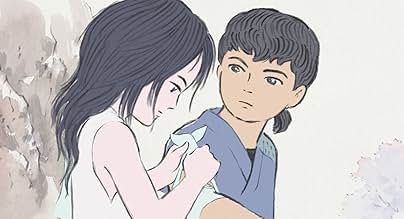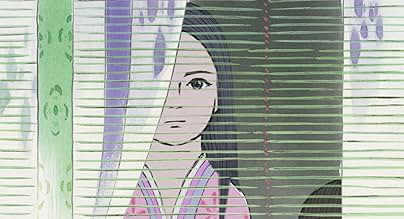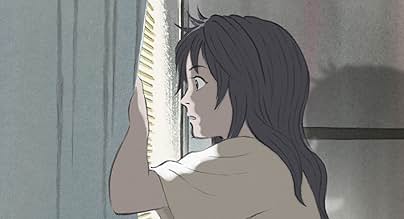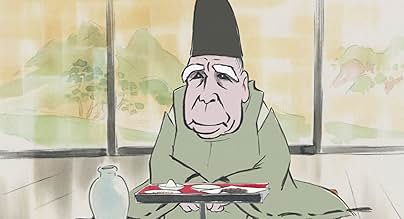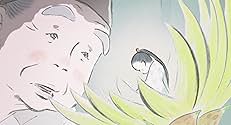Nel profondo di una foresta di bambù, Okina, un'anziana contadina, trova un gambo di bambù misteriosamente incandescente, che dall'interno emerge una minuscola creatura.Nel profondo di una foresta di bambù, Okina, un'anziana contadina, trova un gambo di bambù misteriosamente incandescente, che dall'interno emerge una minuscola creatura.Nel profondo di una foresta di bambù, Okina, un'anziana contadina, trova un gambo di bambù misteriosamente incandescente, che dall'interno emerge una minuscola creatura.
- Regia
- Sceneggiatura
- Star
- Candidato a 1 Oscar
- 13 vittorie e 38 candidature totali
- The Princess Kaguya
- (English version)
- (voce)
- The Bamboo Cutter
- (English version)
- (voce)
- The Bamboo Cutter's Wife
- (English version)
- (voce)
- …
- Prince Ishitsukuri
- (English version)
- (voce)
- Kaguya hime
- (voce)
- …
- Sutemaru
- (voce)
- Okina
- (voce)
- Ôna
- (voce)
- …
- Sagami
- (voce)
- Menowarawa
- (voce)
Recensioni in evidenza
I believe that "Princess Kaguya" is the best Ghibli film in the past 10 years because of the beautiful hand-drawn animation and touching story.
Japanese audience and critics are also very positive for this film, compared to other Ghilbi films.
Hayao Miyazaki is a genius but his recent films are always controversial since "Haul's Moving Castle".
One of the reason is that he relies on his imagination and makes light of a script. That's why quite a few people can't fully understand his recent films and sometimes blame them. ("The Wind Rises" was a tragedy in this meaning.)
Isao Takahata, the director of "Princess Kaguya", is a very good director known for "The Grave of Firefly" but not so active since "My neighbor the Yamada".
His philosophy is very different from that of Hayao Miyazaki. Isao Takahata thinks the scenario is very important and he prefers realism to fantasy.
"Princess Kaguya" is based on the Japanese oldest folklore "The Tale of the Bamboo Cutter". But Isao Takahata transforms it into a universal humanistic story by describing Princess Kaguya as a realistic girl.
This film contains many fantastic scenes and they play as good eye candies. But the brilliantly illustrated life and emotions of the heroine is the most important part in this film. And that's what the director wants us to try to sympathize.
The beautiful and artistic style of this animation is suitable for this theme. Because this apparently unfinished animation gives us the room to imagine by ourselves.
Isao Takahata says, "The animations tend to deprive children of their own imagination by pushing them someone else's fantasy. We have to make another animation which let them imagine by themselves".
I can't wait to see the responses from the worldwide audience! Hope you will like this film too!
I love the way animation can take such simple things as eating a melon or watching birds fly into a tree so much more exciting. By using traditional animation (although I need notice some computerize layouts),The Japanese have done it again with their personal approach to the detail of animation you can only get from 2D.
Adding to my enjoyment, this English adaption of the film includes the voice talent of Chloë Grace Moretz as the princess, who I've become a fan of.
It was very beautiful artwork moving across the big screen.
The film is beautiful. The animation is simple yet exquisite, reminiscent of old Japanese watercolours. Special kudos go to Joe Hisaishi for his superb soundtrack - the final scene and its music left me almost in tears.
The only problems lie in the sometimes slow development of the plot and a few loose ends. There are also tiny deviations from the original story, but I felt that it was as true to it as possible. All in all a beautifully drawn, beautifully crafted movie, solid voice acting (for a Japanese movie at least) and, again, the beautiful music. Excellent job, Ghibli.
Hats down to Mr. Takahata as well.
I really appreciated how much effort was put into capturing the atmosphere of the original material. I haven't read the original material so I don't know how faithful it is to the original as a story, but I also liked the things I thought the movie said about women, life, and women's place in society.
I felt like the story was dragging its feet in places. I generally expect fable-style stories to be faster so that they can appeal to a wider audience and not cause you to start questioning the surreal world.
I want to repeat it for the last time. If you want to experience a fable, there are few, if any, better options to watch.
It's about an elder bamboo cutter named Okina who discovers a young, tiny girl in a bamboo shoot and decides to adopt her as his own along with his loving wife Ona. As years progress, the tiny girl begins to grow rapidly to normal size like the other children of their village, eventually having to leave since her adoptive parents decide to have her raised among the nobles. From there, she is given the name "Princess Kaguya" and things become further complicated when so much is offered to her so suddenly.
When comparing this movie to past Studio Ghibli efforts, it's obvious that the animation style is nothing like its preceding films. And with studio founder Hayao Miyazaki having stepped down and no involvement with this current project, I have to say it's a drastic, yet vibrant change in what Studio Ghibli is widely known for. I loved the story and it had an ending that was rather heartwarming and enough to tug anyone's heartstrings. With the English dub voice of Kaguya done gracefully by Chloe Grace-Moretz (Let Me In, Carrie, If I Stay), she actually stands out well as the title character, like it wasn't forced.
The animation technique was rather intricate, but it was reminiscent of an old Japanese art painting I've once studied about in Art History classes at my local college. American animation studios have believed traditional 2-D to be a dying art form in the film industry these days, but I can tell Japan does not acknowledge it in that way at all, whether it's TV or film. The concept I started believing for the entire film felt like "a timeless painting" and it's quite a stroke of genius, in my opinion.
The music and underscore of Joe Hisaishi has left me engaged that it flows evenly well with the scenes as they play out. But most notably, director Isao Takahata really stepped up following his involvements with titles like "Kiki's Delivery Service," "My Neighbor The Yamadas," and even the touching "Grave of the Fireflies." This entire movie has earned its rightful place in the Studio Ghibli library. This is another example of a Ghibli film where you don't have to be an avid Japanese Anime fan to enjoy it, what matters is that such themes existed in various genres, not just in one medium or one genre alone.
Lo sapevi?
- QuizIn several scenes in the movie, Kaguma-Hime, Lady Sagami and Ona can be seen wearing multi-layered kimonos called Junihitoe. Both the number of layers and the coloring of the layers worn would be dictated by the occasion, status, and season the wearer is in.
- BlooperWhile the baby princess crawls to the cutter she tosses a piece of bamboo to the edge of the floor mat. In the reverse shot as she crawls back, it is missing.
- Citazioni
The Princess Kaguya: [singing] Go round, come round, come round... Come round, oh distant time. Come round, call back my heart. Come round, call back my heart. Birds, bugs, beasts, grass, trees, flowers. Teach me how to feel. If I hear that you pine for me, I will return to you.
- ConnessioniFeatured in Troldspejlet: Episodio #50.12 (2014)
I più visti
- How long is The Tale of The Princess Kaguya?Powered by Alexa
Dettagli
Botteghino
- Budget
- 5.000.000.000 JPY (previsto)
- Lordo Stati Uniti e Canada
- 974.913 USD
- Fine settimana di apertura Stati Uniti e Canada
- 54.915 USD
- 19 ott 2014
- Lordo in tutto il mondo
- 24.751.400 USD
- Tempo di esecuzione2 ore 17 minuti
- Colore
- Mix di suoni
- Proporzioni
- 1.85 : 1







